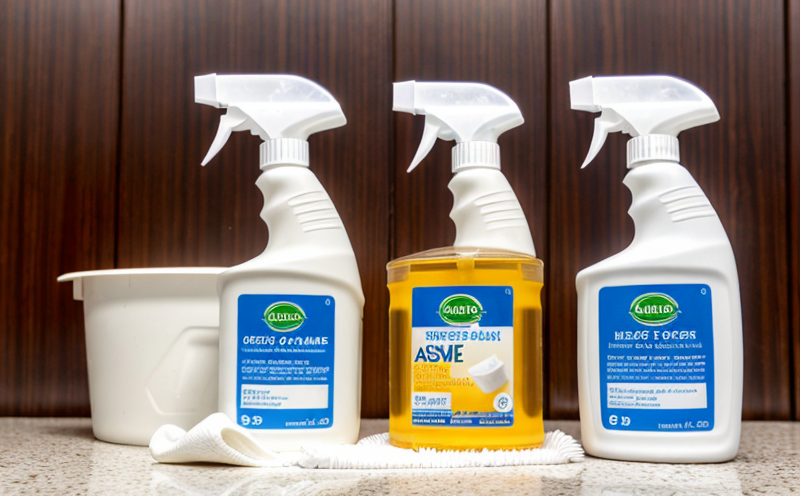EN 14348 Mycobactericidal Testing of Disinfectants
The EN 14348 standard is one of the most recognized international standards for evaluating the effectiveness of disinfectant products in killing mycobacteria, specifically Mycobacterium tuberculosis (M. tb) and Mycobacterium avium (M. avium). This test is crucial for ensuring that cleaning and hygiene products are effective against these bacteria, which can cause diseases such as tuberculosis and nontuberculous mycobacterial infections.
According to EN 14348:2003, the test involves exposing a known quantity of viable M. tb or M. avium cells to the disinfectant under specific conditions (temperature, contact time, etc.). After incubation, the remaining viable bacteria are quantified and compared to a control group not exposed to the disinfectant. The efficacy is expressed as a percentage reduction in bacterial load.
The standard specifies detailed procedures for preparing the test samples, including how to inoculate the media with the mycobacteria and how to ensure that the disinfectant is applied uniformly across all test samples. It also provides guidelines on the types of control media to use and how to perform the incubation period.
The importance of this testing cannot be overstated, especially in healthcare settings where the spread of tuberculosis can have serious public health implications. The results from EN 14348 testing are used by quality managers and compliance officers to ensure that their products meet the necessary hygiene standards set forth by international regulations.
In addition to ensuring product efficacy, the test also serves as a tool for R&D engineers in refining formulations of disinfectants. By understanding how different ingredients affect the killing rate of mycobacteria, they can optimize formulas to achieve higher levels of efficacy while maintaining safety and effectiveness.
The testing process is not just about achieving compliance with EN 14348 but also about ensuring that products perform consistently across various conditions. This is where the role of procurement becomes crucial. By selecting suppliers who adhere strictly to these standards, organizations can ensure a stable supply chain for effective disinfectants.
Given the global nature of many industries, it's important to note that this test is widely accepted in numerous countries around the world. Its recognition ensures that manufacturers and distributors can confidently market their products internationally without facing additional barriers due to differing local standards.
International Acceptance and Recognition
- The United States: Recognized by FDA for compliance with international hygiene regulations.
- European Union: EN 14348 is part of the EU's harmonization efforts to ensure consistent standards across member states.
- Canada: Adheres to the same standards as the US and EU, ensuring seamless trade between these regions.
- Australia and New Zealand: Have adapted EN 14348 into their national standards for disinfectant testing.
The widespread acceptance of EN 14348 means that manufacturers can rely on a consistent methodology when developing and testing their products. This consistency is crucial in maintaining high hygiene standards across different markets, thereby protecting public health globally.
In conclusion, the EN 14348 standard plays a critical role in ensuring the efficacy of disinfectants used to combat mycobacterial infections. By adhering to this standard, manufacturers and suppliers can ensure that their products meet international hygiene standards, thus contributing significantly to public health.
Benefits
The benefits of EN 14348 mycobactericidal testing are manifold. Firstly, it provides a robust framework for evaluating the effectiveness of disinfectants against specific pathogens, ensuring that they meet stringent hygiene standards.
Secondly, this testing helps in the continuous improvement of product formulations. By identifying areas where current products fall short or exceed expectations, R&D teams can innovate and develop more effective solutions tailored to real-world challenges.
Thirdly, compliance with EN 14348 enhances a company's reputation as a leader in hygiene and safety. This is particularly valuable for businesses operating across multiple regions, as it demonstrates their commitment to meeting global standards.
In addition, this testing supports the procurement process by ensuring that only high-quality disinfectants are selected. This not only improves product quality but also reduces operational risks associated with substandard products.
Finally, the results from EN 14348 testing provide critical data for regulatory compliance. This ensures that products can be marketed confidently and without delay in various jurisdictions worldwide.
Environmental and Sustainability Contributions
The EN 14348 standard not only focuses on the efficacy of disinfectants but also considers their environmental impact. By ensuring that disinfectants are effective at lower concentrations, manufacturers can reduce waste and minimize harmful effects on the environment.
Incorporating sustainable practices in product development is becoming increasingly important as companies aim to meet growing consumer demand for eco-friendly solutions. The results from EN 14348 testing help guide these efforts by providing insights into how different ingredients affect both efficacy and environmental impact.
Moreover, the standard encourages the use of less toxic chemicals where possible, which is beneficial not only for the environment but also for users who may be exposed to these products regularly. This dual benefit highlights the importance of balancing hygiene needs with sustainability goals in product development.
In summary, EN 14348 mycobactericidal testing supports a more sustainable approach to disinfectant production by promoting efficient use of resources and reducing environmental footprints without compromising on effectiveness.





